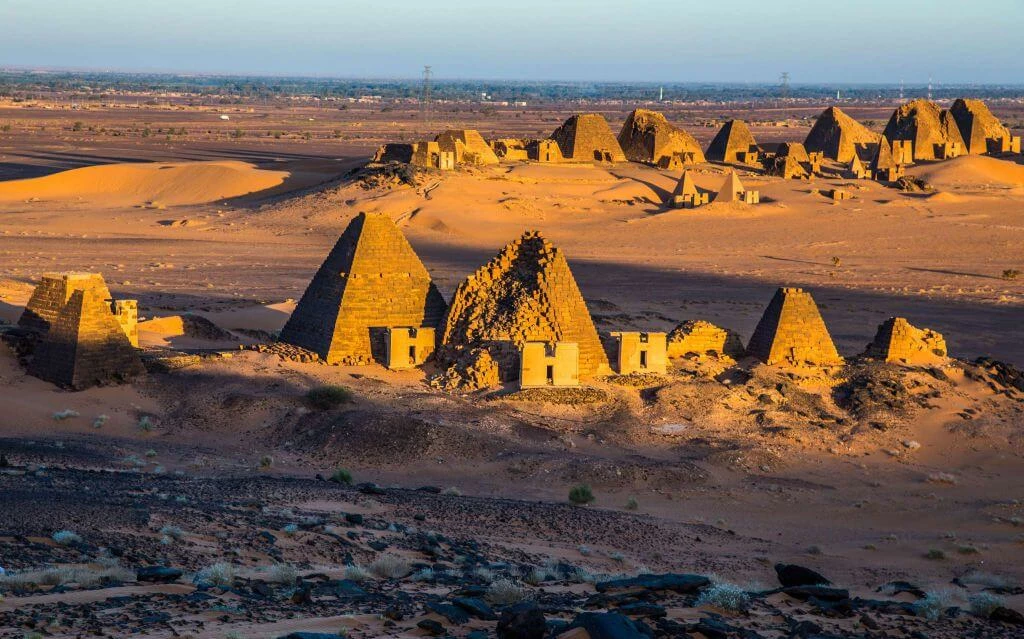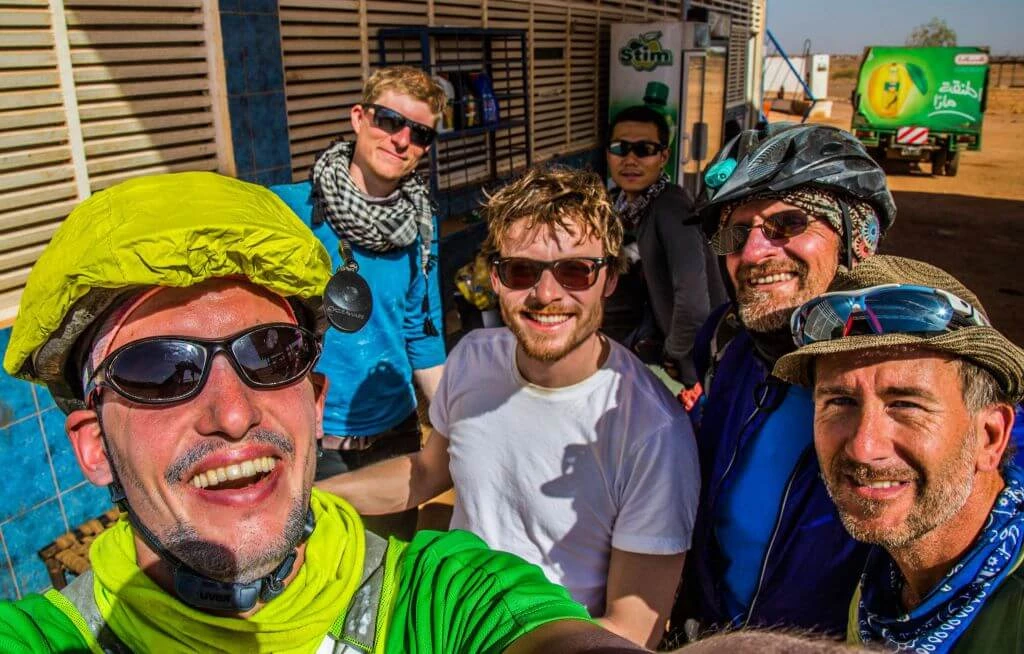Band of Brothers
Wednesday, February 17, 2016
- Three Continents
The days in Dahab with snorkeling were really relaxing. The bus went back to Luxor, where I spent a few more days at Bob Marley Hostel. The nicest and cleanest hostel I have found in Egypt.
Matthias and Mo were already waiting for me at Aswan Station. I met Matthias by chance in Luxor. He is currently also cycling in the direction of East Africa. We drove straight to the Sudanese Consulate where I could apply for my visa.
One day later Marco from China cycled in our camp. He started in China half a year ago and is now trying to reach South Africa. We got to know the fourth cyclist later that evening. Coltàn is originally from Serbia but has been living in Istanbul for some time. To escape the cold winter he drives every year for 3 months through the area.
On the second visit to the consulate we met Michael from Australia. He is a travel journalist and longed for a change after spending two years in South Africa. Since a few months he travels with the backpack through the area. He decided to cycle with us to Khartoum through the desert. A suitable bicycle for him we found after a long search on the market in Aswan. The last participant flew in from Berlin the next day. Caspar, a friend of Matthias, came especially for 3 weeks to visit.

We decided to name BAND OF BROTHERS. In the past, you could only enter Aswan from Aswan by ferry. For some time, however, now exists a road. For cyclists, however, it is still closed due to the security situation. The ferry departs every Sunday, once a week, from Aswan to Wadi Halfa. The wife of Mo served us a delicious Nubian meal last night. Mo helped us with all sorts of things all the time.
The Nubians are a Nilo-Saharan-speaking people today in Sudan and southern Egypt, some of which are heavily mixed with Arab and Black African ethnic groups. Nubia was for Egypt an important source of gold, ivory, skins and slaves and therefore always a target of pharaonic expansion. Nubians in the narrower sense (Nubia) were mentioned for the first time at the time of Christ's birth by Strabon, who calls Eratosthenes a guardian, and described as living on the Nile northwest of Meroe.
The 20-hour crossing was relatively easy. Since the road is open, fewer people use the ferry. We had the whole upper deck for ourselves. The formalities were done pretty soon. At the sight of 6 fully packed touring riders most of the officials were already tired.
In Wadi Halfa we stayed overnight to do our registration and the travel permit. All tourists must register for $ 40 at the latest after 3 days in Sudan and need a permit to travel. Some things impressed us at the registration office. Compared to Egypt everything runs off right here. There are computers, all employees speak English and you can see a lot of women working at the counter.

In a good mood we headed off to the Nubian Desert. The streets are also in a much better condition here than in the northern neighboring country. In addition, a strong wind blows from the north every day. Holland can definitely pack in comparison to the Sudan. Flat roads, good roads, tailwind and friendly people. What always accompanies you in the desert is the sand. At first he is in his shoes, at some point you have him in the sleeping bag and finally it crunches between his teeth.
The main dish in Sudan is Fool, pureed buffer beans with onions and oil. As a side dish you usually get bread and egg. In Abri we stayed in a Nubian guesthouse again and drove to Wawa the next day to visit the Soleb temple there.
The site has a large sandstone temple built by Amenhotep III. has been erected. It is the so far southernmost known temple of this king. He was dedicated to the god Amun-Re and the ruler himself. Architect was probably Amenhotep, son of Hapu.

For most of the sites we visited in Sudan, we were often the only visitors. People are always happy to see tourists. A stark contrast to Egypt. Admission usually costs around 50 Sudanese pounds. According to the official exchange rate, this is approximately 9.- Euro. However, the price has already changed on the black market for a long time. $ 1 USD is officially traded for 6 Sudanese pounds, while getting 10 and more pounds on the black market. For many people, many everyday things have become almost unaffordable.
We mostly stayed somewhere in the desert. The peace and the starry sky here are just gigantic. But also the temperature differences. During the day, the thermometer rises to over 30 degrees and at night it drops to 5 degrees. During the day you sweat like crazy and you freeze during the night. Two days later we visited Deffufa.
At the beginning of the 2nd millennium BC BC, the place was the center of the Kerma culture. The central facility of the city was a large massive mud brick building, which is today referred to as Lower or Western Deffufa (Nubian "brick ruin"). The function of the 19-meter high and widely visible building is controversial, it was either a palace or a temple. Numerous Egyptian objects could be found, which on the one hand were certainly traded, on the other hand, perhaps were captured during military campaigns. At the decline of the empire Kerma was taken by the Egyptians. The place was abandoned around 400 AD.

Thanks to the tailwind, we made good progress and were already in Dongola in the evening, where we took a break for two days to take the bus to Karima.
The Jebel Barkal (287 m, Barkal means "holy") is a small mountain in northern Sudan. The Barkal is surrounded by a vast field of ruins that includes several temples, important "palaces" and a pyramidal necropolis. The buildings together with the finds in Sanam, the ancient city of Napata. Therefore, the mountain Barkal, Sanam and other local sites in 2003 received the UNESCO World Heritage status. At least since Thutmose III. in the 15th century BC BC, from which the earliest excavated ruins date, was the Egyptians' Barkal as the southern counterpart to the temple complex in Karnak (Luxor) and the residence of the god Amun. Until the 20th Dynasty, the Barkal was the most important religious center of the Egyptians in Nubia.
The pyramids and tombs south of today's village al-Kurru (also el-Kurru) in Sudan are the oldest part of the cemetery around the Nubian city of Napata. The cemetery is located about 10 kilometers south of its center on Mount Barkal, on the western side of the Nile. The oldest tombs date back to 860 BC Dates back to the time before the founding of the kingdom of Kush in Nubia.
The last sight on our trip along the Nile we visited in Old Dongola. With the ferry we crossed the river to visit the former city. I found the cemetery the most impressive of all.
Old Dongola was the capital of the Nubian-Christian Empire of Makuria. The origins of the city are still unclear. They were perhaps founded as a fortress by one of the first rulers of Makuria at the end of the fifth century. From the 9th to the 11th century, Dongola and the kingdom of Makuria flourished. A total of 14 churches have been identified so far.
New buildings were built in the city. These include the throne room of the Royal Palace, which still stands today, since it was later converted into a mosque. After the 11th century, the city faced the decline. The old churches were partially renovated, and new churches were built, but they were rather small. In the 13th century, the empire of Makuria fell apart, and Dongola lost its importance.

The next day we loaded our bicycles with plenty of food and water to say goodbye to the Nile and cycle 320 km across the desert to Khartoum, the capital of Sudan. Exactly this loneliness and peace I have often missed in Egypt and Jordan. Only partially we had crosswinds. Most of the time the strong tailwind pushed us forward. After 2 weeks we finally reached our common goal, Khartoum.
With the bus we headed north again to visit the pyramids of Meroe and to bivouage there for one night.
The mostly pyramid-shaped pyramids of Meroe are at a height of less than 30 meters, much smaller than the known ancient Egyptian pyramids and served as kings, queens and high officials of the historic kingdom of Kush in Nubia as tombs. Their period of origin ranges mainly from about 300 BC. Until about 300 AD The Merano pyramids have been a UNESCO World Heritage Site since 2011.

The BAND OF BROTHERS made their last joint trip to the Sufi ceremony in Omdurman. The people here were very happy about our visits. We were just allowed to participate in their ritual and even sit in front of the holy shrine for a while. You felt as part of society. With their colorful robes, drums and songs a great atmosphere developed over time. Men, women and children of all ages celebrated in a big dance all together until sunset.
The Burhani Tariqa is an Islamic Sufi Order (Tariqa) of Sayyid Ibrahim al-Qurashi ad-Disuqi, the fourth of the great Sufi oaks and Order founders. The Burhani Tariqa spread for the first time in the era of Sheikh Muhammad Uthman Abd al-Burhani († 1983). Under Sheikh Muhammad Uthman, the Tariqa found numerous followers in Sudan and Egypt - in the 1970s estimates in Egypt alone numbered in the hundreds of thousands. Sheikh Muhammad Uthman, nicknamed Sayyid Fahr ad-Din, died on April 5, 1983 and is buried in Khartoum. His grave is today a much visited place of pilgrimage.
Caspar flies back home from here. With a heavy heart Michael put his single speed bike on the side and now travels by bus. This was the first time that I cycled in such a large group. The time was enormously eventful and I would like to take this opportunity to thank all my BROTHERS for the great time.
